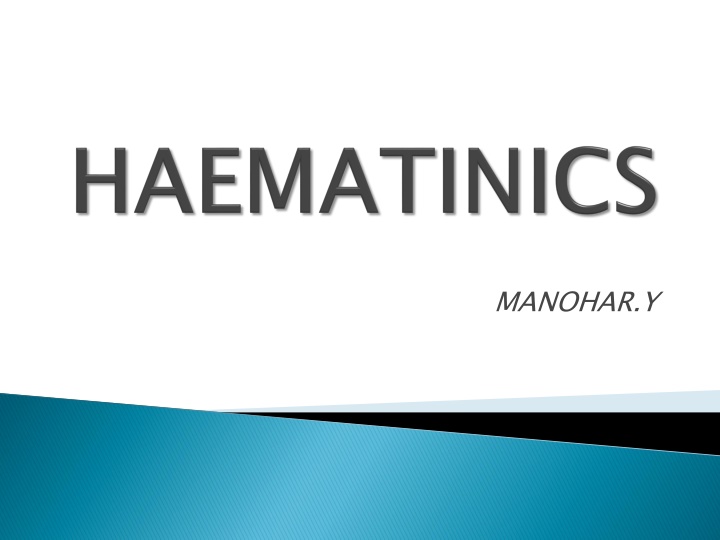
Iron Absorption and Treatment of Anemia - Factors, Sources, and Process
Understand the absorption of iron in the body along with the treatment of anemia, including factors affecting absorption, rich sources, and utilization in cells. Explore the mechanisms involved in iron absorption and the necessary agents for forming blood cells to combat anemia.
Download Presentation

Please find below an Image/Link to download the presentation.
The content on the website is provided AS IS for your information and personal use only. It may not be sold, licensed, or shared on other websites without obtaining consent from the author. If you encounter any issues during the download, it is possible that the publisher has removed the file from their server.
You are allowed to download the files provided on this website for personal or commercial use, subject to the condition that they are used lawfully. All files are the property of their respective owners.
The content on the website is provided AS IS for your information and personal use only. It may not be sold, licensed, or shared on other websites without obtaining consent from the author.
E N D
Presentation Transcript
These are the agent required in the formation of blood & used for treatment of anaemia's. Aetiology: Aetiology:-Anaemia occurs when, A.Blood loss (acute or chronic) B. Impaired red formation due to; a)Deficiency of iron,vit.B12. folic acid. b)Bon marrow depression. C. Increased destruction of RBCs.
Classification:- 1.Iron 1.Iron & it s compound: & it s compound:- - Oral Oral:ferrous succinate, ferrous sulfate, ferrous gluconate, ferrous fumarate etc. Parenteral ferrous sucrose and ferrous carboxymaltose 2 2. Maturation Vitamin:B12 cynocobalamine,Hydroxycynocobalamine. Folic acid 3 3. Miscellaneous copper,cobalt,Riboflavin. Parenteral:Iron dextron, Iron-sorbitol-citric acid . Maturation factors: factors:- - . Miscellaneous:-
1.Iron: According to Greek thought MARS is the god of strength & IRON is dedicated to it. 1.Iron: Source of iron: Rich:- Liver, egg yolk, dry bean, dry fruit. Medium:- Meat, chicken, fish, banana, apple. Poor:- Milk & it s product. Daily requirement Adult male :- 0.5-1mg(13 g/kg). Adult female:-1-2mg(21 g/kg). Infant :-60 g/kg. Children :-25 g/kg. Pregnancy :-3-5mg(80 g/kg) Source of iron:- - Daily requirement: :- -
Iron absorption: Its absorption occurs all over the intestine. Iron absorption: In the stomach containing HCL & reducing agent are convert the ferric to ferrous. Two separate iron transporters in the intestinal mucosal cells function to effect iron absorption. At the luminal membrane the divalent metal transporter 1 (DMT1) mucosal cell. divalent metal transporter 1 (DMT1) carries ferrous iron into the The ferroportin pass through mucosal cell directly into the blood steam. ferroportin are bound with ferrous iron &
Factors decrease iron absorption:- 1. Achlorhydriya 2. Alkline pH 3. Presence of food in stomach. 4. Complex with tetracycline & phosphate. Factors facilitating iron absorption: 1.Acid 2.Reducing substances like ascorbic acid,aminoacids 3.Meat
Transport, utilization, storage and On entering plasma it is converted to the ferric form and complexed with a glycoprotein transferrin (Tf). Iron is transported into erythropoietic and other cells through attachment of transferrin to specific membrane bound transferrin receptors(T f Rs). The complex is engulfed by receptor mediated endocytosis. Iron dissociates from the complex at the acidic pH of the intracellular vesicles. The released iron is utilized for haemoglobin synthesis or other purposes. Tf and T f R are returned to the cell surface to carry fresh loads. Transport, utilization, storage and excretion: excretion:
Storage: 1.Reticulo endothelial cell in liver. 2. Spleen 3. Bone marrow 4. hepatocytes and myocytes. Excretion: Daily excretion in adult male is 0.5 1 mg, mainly G.I. mucosal cells, some RBCs and in bile from faeces. Other routes are skin, very little in urine and sweat. In menstruating women, monthly menstrual loss may be averaged to 0.5 1 mg/day. Storage:- - Excretion:- -
1. Epigastric pain. 2. heartburn. 3. nausea, vomiting. 4. staining of teeth. 5. metallic taste. 6. Constipation. Preparations 1.Ferrous succinate (35%) 2. Ferric ammonium citrate (5%) 3. Ferric gluconate (12%) 4. Ferrous fumarate(33%) Preparations and dose: and dose:- -
Parenteral iron: indicated only when: 1.Oral iron is not tolerated: bowel upset is too much. Parenteral iron:- - Iron therapy by injection is 2. Failure to absorb oral iron: malabsorption. 3. Non-compliance to oral iron. 4. In presence of severe deficiency with chronic bleeding. 5. Along with erythropoietin preparations for parenteral use are: (i) Iron- dextran. (ii) Iron-sorbitol-citric acid
Therapeutic use: 1.Iron deficiency anaemia. Therapeutic use:- - 2. Megaloblastic anaemia. 3. As an astringent :-Ferric chloride is used in throat paint. Iron Iron poisoning: poisoning: deferoxamine deferoxamine. .
3.MATURATION FACTORS: VITAMIN-B12 (Cyanocobalamin) 3.MATURATION FACTORS: 1.Vit B12 occurs as water soluble, thermostable red crystals. 2.It is synthesized in nature only by microorganisms; plants and animals acquire it from them. Dietary yolk, meat, cheese. Dietary sources sources :-Liver, kidney, sea fish, egg Daily lactation 3 5 g. Daily requirement: requirement: 1 3 g, pregnancy and
Metabolic functions: Vit B12 is essential for the conversion of homo- cysteine to methionine. Methionine Plays protein structure and in metabolism. Metabolic functions:- - Purine and pyrimidine synthesis . Vit B12 is essential for cell growth and multiplication.
Utilization of Intrinsic factor secreted by stomach forms a complex with B12 attaches to specific receptors present on intestinal mucosal cells and is absorbed by active carrier mediated transport. Utilization of vit vit B12 B12 : : Vit B12 is transported in blood in combination with a specific globulin transcobalamin II (TCII). Vit B12 is especially taken up by liver cells and stored about 2/3 to 4/5 of body s content (2 8 mg) is present in liver. It is excreted mainly in bile but this is reabsorbed by entero-hepatic circulation occurs.
.The absence of intrinsic factor or when there is malabsorption. From parentral route (i.m/s.c) is mainly excreted via urine. Deficiency Pernicious anaemia. Other cause of gastric mucosal damage. Malabsorption. Nutritional deficiency Deficiency: :- - Manifestations Manifestations of deficiency are: Megaloblastic anaemia g.i. disturbances Neurological degeneration. of deficiency are:- -
Preparations, dose, administration: Cyanocobalamin:- MACRABIN 35 g/5ml Hydroxocobalamin: -REDISOL-H, Methylcobalamin:-METHYLCOBAL 0.5 mg tab. Preparations, dose, administration:- - Therapeutic Pernicious anaemia. Malabsorption syndrome. Nutritional deficiency. Neurological condition. Psychiatric disorder. . Therapeutic use: use:- - Adevers Adevers effects: Allergic reactions have occurred by injection effects:-
FOLIC FOLIC ACID: Folic acid(Pteroyl glutamic acid) is a member of the B complex group of vitamin. ACID: Dietary sources:- Liver, green leafy vegetables (spinach), egg, meat, milk. Daily requirement:- 0.2 mg/day
Utilization: Folic acid is present in food as poly-glutamates Utilization:- - Glutamate residues are split off primarily in the upper intestine before being absorbed. Reduction to DHFA and methylation also occurs at this site. It is transported in blood mostly as methyl- THFA which is partly bound to plasma proteins. Small, physiological amounts of folate are absorbed by specific carrier-mediated active transport in the intestinal mucosa.
Folic acid is rapidly extracted by tissues and stored in cells as polyglutamate. Liver takes up a large part and secretes methyl-THFA in bile & again reabsorbed by entero-hepatic cycle 50-90% may be excreted in urine.
Metabolic 1Conversion of homocysteine to methionine: Metabolic functions: functions: 2. Generation of thymidylate, an essential constituent of DNA: 3. Conversion of serine to glycine. A precursor to proteins Glycine is an inhibitory neurotransmitter in the central nervous system 4. Purine synthesis. 5.Histidine metabolism: histidine Formiminoglutamic acid (FIGLU) tetrahydrofolic acid glutamic acid.
Deficiency & 1.Megaloblastic anaemia. 2. Nutritional deficiency. 3. Malabsorption. 4. Epithelial damage. 5. Weight loss. Deficiency & menifestation menifestation: :- - Therapeutic 1.Megaloblastic anaemia. 2. Improve absorption. 3. Protect epithelial cell. 4. Growth factor. Therapeutic use: use:- -
Adverse effects Hypersesitivity reaction occur by injection. Adverse effects: :- - Preparations Oral : Preparations and and dose: dose: Folic acid Folvite,folitab 5 tab. Injectabale: Folinic acid:-calcium leucovorin 3 mg/ml inj.
3.Miscellaneous Copper : Haeme synthesis is interfered in copper Deficiency. Dose 0.5 5 mg of copper sulphate. 3.Miscellaneous: :- - Copper :- - Cobalt: It stimulates erythropoiesis by inducing tissue hypoxia increased erythropoietin production. Cobalt:- - Riboflavin : Hypoplastic anaemia occurs in riboflavin deficiency. Riboflavin :- -
These are high molecular weight substances which exert colloidal osmotic(oncotic)pressure. when infused i.v. retain fluid in the vascular compartment. They are used to correct hypovolemia due to loss of plasma/blood.
Ideal properties of a plasma expander are: Ideal properties of a plasma expander are: 1.Should exert oncotic pressure comparable to plasma. 2. Should remain in circulation and not leak out in tissues. 3. Should be pharmacodynamically inert. 4. Should not be pyrogenic or antigenic. 5. Should be stable, easily sterilizable. Dextran It is a polysaccharide obtained from sugar beat
Dextran: Dextran: It is a polysaccharide obtained from sugar beat . Dextran Dextran- -70 The more commonly used preparation is dextran70. It expands plasma volume for nearly 24 hours. it is slowly excreted by glomerular filtration as well as oxidized in the body over weeks. Some amount is deposited in RE cells. Dextran has nearly all the properties of an ideal plasma expander. 70 :
Dextran It acts more rapidly than dextran-70. It reduces blood viscosity. Microcirculation may improve. Dextran- -40: 40: Polyvinyl Polyvinyl pyrrolidone pyrrolidone (PVP) (PVP) : : It is a synthetic polymer (average MW 40,000) used as a 3.5% solution. It interferes with blood grouping and cross- matching and is a histamine releaser. PVP is slowly excreted by kidney and small amounts by liver into bile. It is stored in RE cell
USE OF PLASMA EXPANDERS: 1. Plasma loss. 2. Burn 3. Hypovolemic & endotoxin shock. 4. Sever trauma & extensive tissue damage 5. Whole blood loss. USE OF PLASMA EXPANDERS:- - Contraindications 1.severe anaemia. 2. cardiac failure. 3. Pulmonary Oedema. Contraindications:


